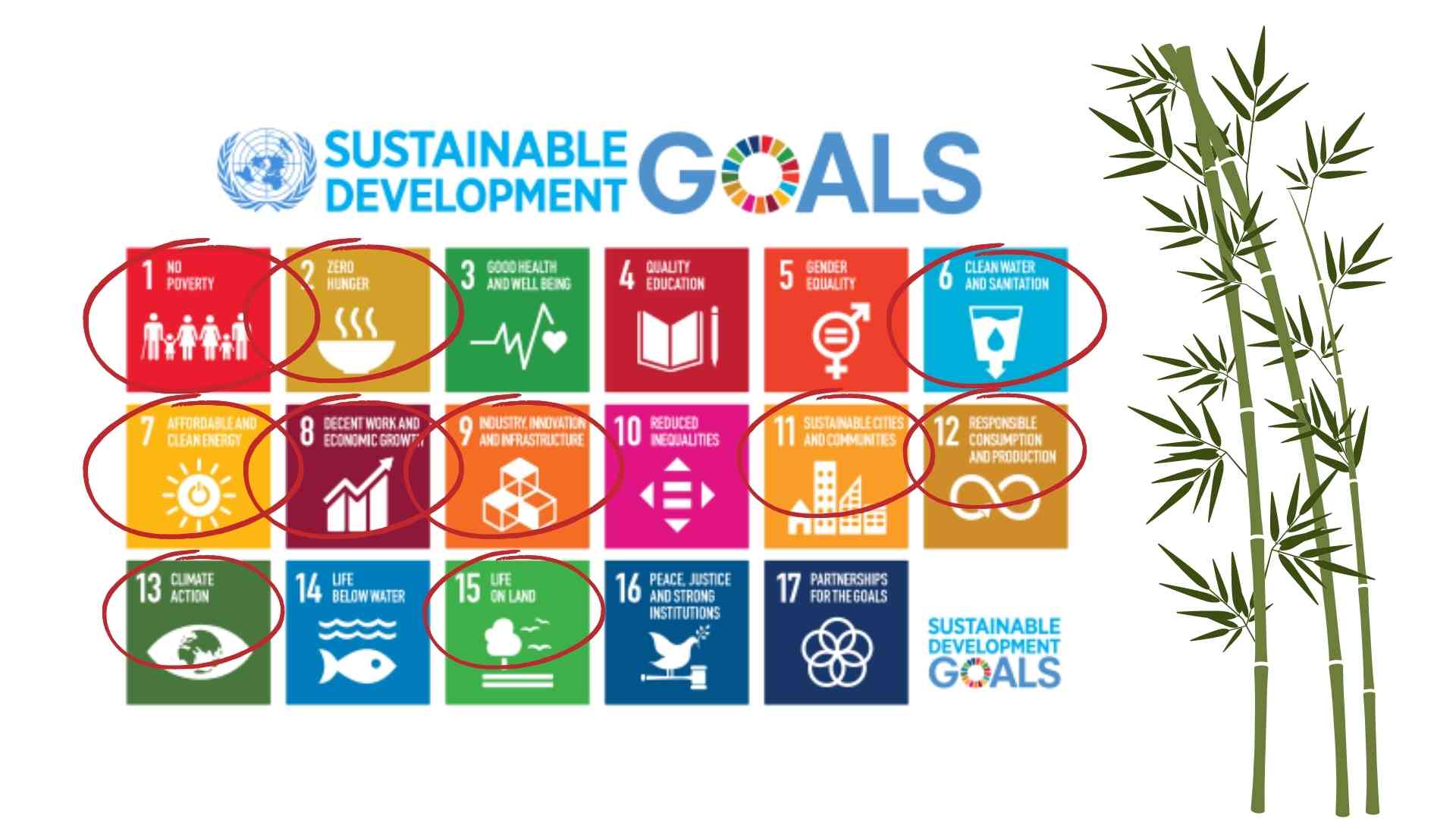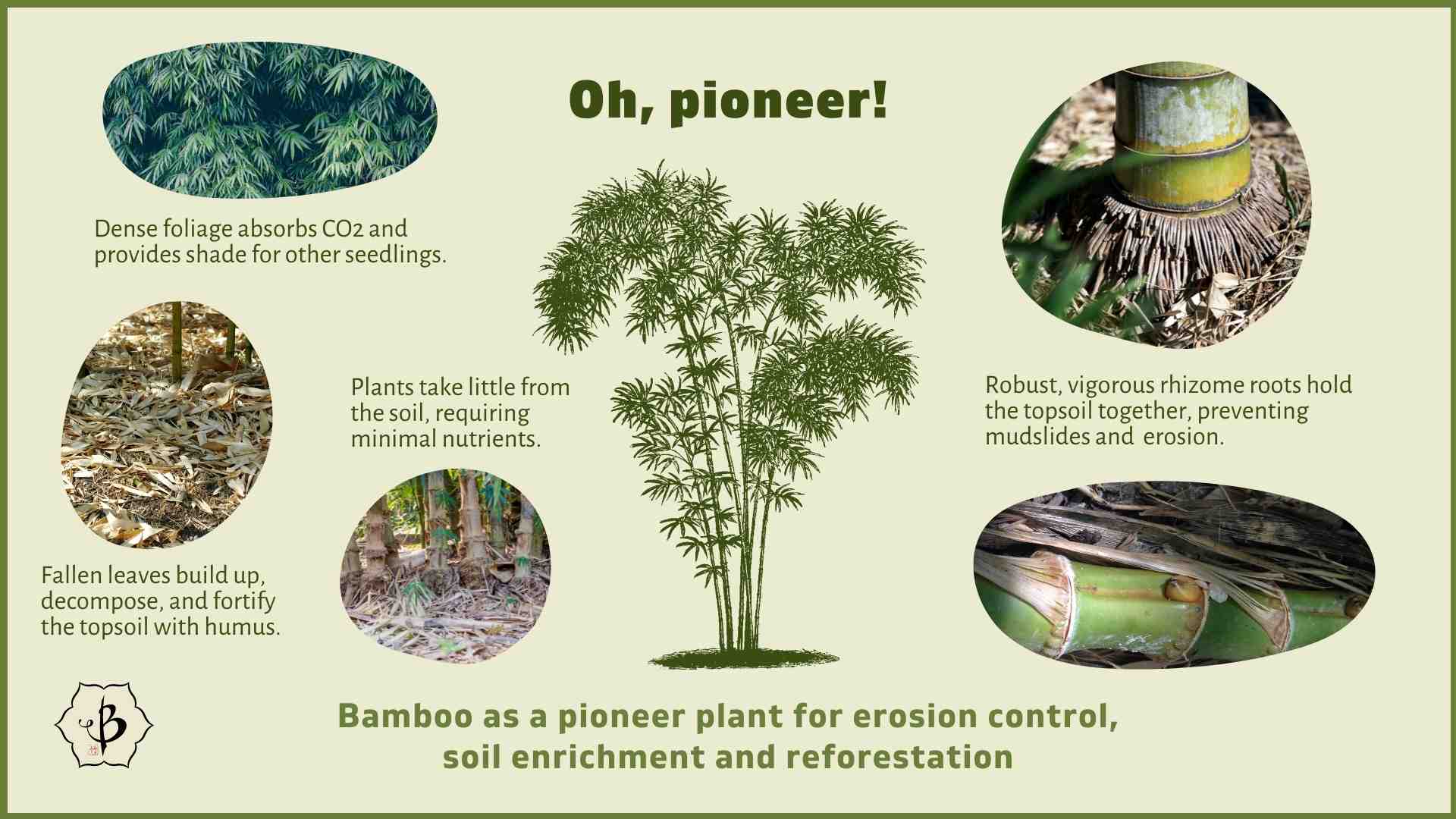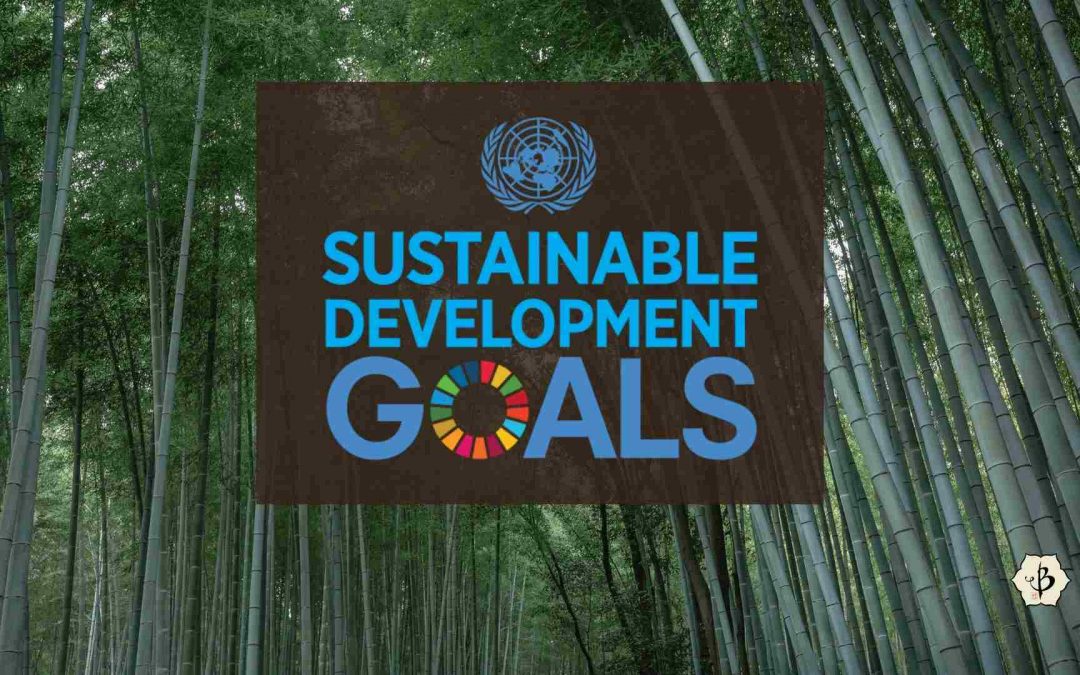It’s something of a foregone conclusion among treehuggers and environmentalists that bamboo can save the planet. We wax rhapsodically over this woody grass’s capacity to stop deforestation and replace fossil fuels. We speak in glowing hyperbole about bamboo’s astonishing growth rate and incomparable renewability. Our optimism is not unwarranted, but it’s necessary, from time to time, to check in with hard facts and measurable results. And it’s important to hold bamboo up to certain international standards, like the United Nations Sustainable Development Goals, to see where it stands.
The United Nations created a set of 17 Sustainable Development Goals (SDGs) in 2015 as “A blueprint to achieve a better and more sustainable future for all.” These global goals are broad and interconnected, touching on a range of social, economic, and environmental issues, where public and private entities can focus their efforts on fostering a healthier planet. And without a doubt, bamboo has great potential to address and advance at least half of these 17 sustainability goals.
The UN’s 17 SDGs include No Poverty; Zero Hunger; Good Health and Well-being; Quality Education; Gender Equality; Clean Water and Sanitation; Affordable and Clean Energy; Decent Work and Economic Growth; Industry, Innovation and Infrastructure; Reduced Inequality; Sustainable Cities and Communities; Responsible Consumption and Production; Climate Action; Life Below Water; Life On Land; Peace, Justice, and Strong Institutions; Partnerships for the Goals.
United Nations Sustainable Development Goals
As the threat of Climate Change continues to grow more serious, posing a disproportionate danger in the developing world, the United Nations has declared a set of Sustainable Development Goals to lead our planet to a safer, healthier future. These complex and ambitious goals call for many layers of international cooperation. And bamboo is one resource that can play a valuable role in pursuing many of these goals.
As an annual grass that can be harvested regularly without the need for replanting, and with minimal need for fertilizers and pest control, bamboo is a paragon of sustainability. As it grows, bamboo removes CO2 and sequesters it in the roots and soil underground, at the same time replenishing the atmosphere with generous quantities of oxygen. Without losing trees or drilling oil, we can make paper, textiles, furniture, and houses from bamboo.
In disenfranchised communities and degraded landscapes, bamboo offers a path to job creation and soil restoration. Bamboo might not save the planet by itself, but it is a vital tool in the quest for greener forests, bluer skies, and stronger communities.

1. No Poverty
SDG #1 calls for action to: “End poverty in all its forms everywhere.”
A goal like this will require massive and coordinated efforts, but bamboo is one cash crop that can create significant economic opportunities in the developing world. There happens to be a strong correlation between the global regions most suitable for bamboo farming and those most severely impacted by poverty.
Native bamboo species flourish in Southern Asia, sub-Saharan Africa and Latin America. In a South-to-South cooperation, many farmers in these regions have also taken to importing tropical bamboo varieties from other areas for commercial cultivation. As forests are gradually depleted and demand for non-tree timber increases, the developing world has prime access to this fast-growing, woody resource.
Timber bamboo can provide a meaningful income by satisfying some of the American and European appetites for building material, while also supplying local populations with an affordable and more sustainable alternative to concrete and steel. In addition to building material, bamboo can also be turned into an enormous range of other products, with both practical and commercial value, including charcoal, paper, and textiles.
2. Zero Hunger
Goal #2 says to: “End hunger, achieve food security and improved nutrition, and promote sustainable agriculture.”
Bamboo can actually improve the food supply in a variety of ways. In the poorest of communities, bamboo shoots offer a simple and readily available form of sustenance. Throughout Asia and Africa, people have incorporated fresh bamboo into their diets for many centuries.
Additionally, bamboo is an excellent pioneer crop that can do wonders to restore degraded landscapes and fortify the topsoil. In this way, bamboo can improve growing conditions and increase crop yields. Through reforestation efforts, bamboo groves can even alter local weather patterns and attract more precipitation, making farms still more productive.
Finally, bamboo biochar is a popular product to make from residual bamboo material and smaller branches. When added to the soil, biochar attracts beneficial microbes and helps with moisture retention. This is one more way that local bamboo farming and industry can increase local food production and help to alleviate hunger.
3. Good Health and Well-being
SDG #3 aims to: “Ensure healthy lives and promote well-being for all at all ages.”
If farming bamboo can provide a livelihood and help a rural community construct better quality housing, then there’s a small step towards greater well-being.
4. Quality Education
SDG #4 is: “Ensure inclusive and equitable quality education and promote lifelong learning opportunities for all.”
This is an area where bamboo doesn’t play a direct role. But there are companies in Africa building bamboo bicycles to help young people in rural communities commute to school.
5. Gender Equality
SDG #5 strives to: “Achieve gender equality and empower all women and girls.”
Here’s another area where bamboo doesn’t have a direct impact, but it’s interesting to see how many female-owned companies are operating in the bamboo space. As this goal intersects with most of the other SDGs, it’s important to ensure that men and women are deriving their equal share of benefits from bamboo cultivation and industry.
Also see our article on Women of the Bamboo World.
6. Clean Water and Sanitation
SDG #6 says to: “Ensure availability and sustainable management of water and sanitation for all.”
The capacity for bamboo to filter water and leach toxins from the soil makes it especially valuable in developing regions where access to clean water is limited. Bamboo’s extensive and tenacious network of roots and rhizomes act like a filter when planted near moving water. The plants are also able to draw toxins out of the soil, through the process of phytoremediation.
In parts of Africa, they plant bamboo near the water pumps in order to drink up the spilled water and deprive malaria-carrying mosquitoes of their breeding grounds. At the same time, well-established bamboo groves can also draw the groundwater upward, increasing the viability of farming in otherwise arid habitats.
See our article on Bamboo for water purification.
7. Affordable and Clean Energy
Goal #7 is to: “Ensure access to affordable, reliable, sustainable and modern energy for all.”
In large areas of Africa and Asia, it’s still very common for people to burn charcoal for the majority of their heating and cooking needs. In most cases, this charcoal is produced from trees and by means of traditional, inefficient methods. It’s hard to imagine a worse use for a tropical hardwood tree than to make it into charcoal.
Bamboo, which grows incomparably faster, provides another, far more sustainable source of charcoal. Relatively simple machinery can also ensure that the process is many times cleaner and more efficient than the traditional earth pit kiln. Even if you are making a greater value-added product from the best bamboo poles, you still end up with inferior culms and other byproducts that are well-suited for charcoal.
It’s not as good as making energy from the sun, but it’s a huge improvement over the status quo.
Fast-growing and high in cellulose, bamboo can also provide an abundant feedstock for bio-ethanol. Rather than making ethanol from a food crop, such as corn, using bamboo won’t have the unintended consequence of driving up food prices. Bamboo also grows well in poor soil conditions where other commercial crops aren’t as viable. And once the bamboo is well established, after about six years, you can harvest it every year.
8. Decent Work and Economic Growth
SDG #8 says: “Promote sustained, inclusive and sustainable economic growth, full and productive employment and decent work for all.”
The tremendous utility and versatility of bamboo means that bamboo cultivation can create a vast range of employment opportunities. Throughout the value chain, from farming to processing to marketing and management, a whole industry is waiting to emerge.
The greatest demand for bamboo products comes from Europe and the United States, regions that are not especially well suited to grow bamboo of their own. Raw material, i.e. hollow bamboo poles, are not easy to ship, and have no value added. It’s essential, therefore, for bamboo growing countries in the developing world to establish their own industry, in order to make the best use of their bamboo crops and reap the benefits of value addition.
9. Industry, Innovation and Infrastructure
Goal #9 is to: “Build resilient infrastructure, promote inclusive and sustainable industrialization, and foster innovation.”
From simple machinery to make bamboo toothpicks and toothbrushes, to elaborate factories processing bamboo into paper, textiles, and engineered building materials, the industrial opportunities are almost unlimited.
In many areas where bamboo grows best, including Southeast Asia and sub-Saharan Africa, there is immense room for new innovation. Whether it’s finding new and better ways to process recognized products, or designing and developing entirely new products, the potential is enormous.
10. Reduced Inequality
SDG #10 says: “Reduce income inequality within and among countries.”
Proper management of bamboo production should allow developing countries to better leverage their natural resources. This should give them a better footing in relation to wealthier nations. But it will take more than a robust bamboo industry to make meaningful progress towards this goal.
11. Sustainable Cities and Communities
The eleventh sustainability goal is to: “Make cities and human settlements inclusive, safe, resilient, and sustainable.”
This SDG calls from some pretty specific benchmarks, but bamboo can contribute to the economy and ecology as described above. With so many applications for land restoration, food production and construction materials, bamboo can have a major impact on making communities more sustainable.
Unlike other crops, bamboo requires far fewer inputs in the way of imported pesticides and fertilizers. Tropical bamboo is native to the climates and terrains of the developing world, and will grow here more easily than most exotic crops. And as an alternative to mining activities, bamboo will make a much more positive impact on the environment, while also allowing local communities to retain a greater share of profits and revenues from the industry.
12. Responsible Consumption and Production
Goal #12 is to: “Ensure sustainable consumption and production patterns.”
By now, it should be obvious that bamboo can offer a way more sustainable and environmentally responsible raw material for construction and consumer products. The building industry generates close to 40% of greenhouse gasses worldwide, especially through the production of concrete and steel. In both the industrial world and the developing world, bamboo provides an excellent alternative that is generally cheaper and certainly has a smaller carbon footprint.
In terms of packing and single-use items like straws and utensils, petroleum-based plastics currently dominate that industry. Bamboo, again, offers a superior alternative that is less intensive to produce, more reusable for the consumer, and easily biodegradable when it reaches the end of its lifespan.
13. Climate Action
Goal #13 ask us to: “Take urgent action to combat climate change and its impacts by regulating emissions and promoting developments in renewable energy.”
To stop deforestation and remove CO2 from the atmosphere, bamboo is an absolutely essential resource. Once established, woody timber bamboo can be harvested annually to produce virtually any product that would otherwise be made from trees which take anywhere from 15 to 40 years to reach maturity.
As bamboo poles are harvested, the plants survive in the roots. That’s also where bamboo sequesters carbon dioxide. In the meantime, with its remarkable growth rate, a healthy grove of bamboo can generate about 35% more oxygen than an equal area of trees.
More innovation is still needed to make bamboo fuel a viable and competitive option, but as oil prices continue to soar, bamboo ethanol and energy make more and more sense.
Reducing the need for deforestation and petroleum, bamboo is one of the most valuable tools we have for combating climate change.
14. Life Below Water
Goal #14 calls for us to: “Conserve and sustainably use the oceans, seas and marine resources for sustainable development.”
Making more packaging, utensils and single-use items from bamboo instead of plastic could make a big difference in the amount of disposable litter that ends up in the ocean. But the seas are not where bamboo will make its greatest impact.

15. Life On Land
SDG #15 says to: “Protect, restore and promote sustainable use of terrestrial ecosystems, sustainably manage forests, combat desertification, and halt and reverse land degradation and halt biodiversity loss.”
Areas degraded by mining, logging and overfarming are not hospitable to wildlife and are now susceptible to further disasters like floods and landslides. Bamboo, with its tenacious roots and minimal nutrient needs, is a perfect plant to restore these lands, bind the terrain together and bolster the topsoil.
Bamboo will grow quickly and make the landscape more inviting to other species of both flora and fauna. At the same time, bamboo roots can draw the groundwater upwards and create more favorable conditions for the return of native species.
16. Peace, Justice, and Strong Institutions
Goal #16 says to: “Promote peaceful and inclusive societies for sustainable development, provide access to justice for all and build effective, accountable and inclusive institutions at all levels.”
I wish bamboo could accomplish this crucial goal. But unfortunately, we’ll have to leave this one to the lawyers and policymakers.
17. Partnerships for the Goals
The last goal on the list calls for measures to “Strengthen the means of implementation and revitalize the global partnership for sustainable development”. This is more of a meta-goal, which applies to the enactment, enforcement, and implementation of the other 16 goals. As such, it’s beyond the purview of what bamboo can specifically achieve.
Conclusions
As we can see, if we hope to achieve the UN’s Sustainable Development Goals and other emissions goals as set by the Kyoto Protocol and the Paris Agreement, we will need to tap into bamboo’s vast potential for restoring forests, enriching the soil, and replacing less sustainable products like concrete, steel, and traditional lumber. Time is running out to save our tropical forests and prevent catastrophic levels of atmospheric CO2.
The technology already exists to employ bamboo for fuel, paper, textiles and construction material. In terms of cultivation, it’s among the easier crops to establish, and absolutely one of the most renewable, fast-growing and versatile. But achieve these ambitious goals and ward off global disaster, additional investment and political will are needed. Public policy in the developing world needs to encourage more cultivation as well as prudent utilization of existing bamboo stands. Education is needed so that bamboo can be properly incorporated into reforestation efforts. And there’s still plenty of room for research and development in the areas of bamboo industry and production.
People like to say that bamboo is so vigorous it will grow by itself. That’s nearly true. But the fact is, given the current state of affairs, we need to take serious action to support and expand this young and promising industry. Only through drastic measures and concerted cooperation can we achieve our goals and ensure a healthy world for our future generations.
Develop your knowledge
If you’re passionate about healing the planet and forging a more sustainable future, then don’t underestimate the importance of bamboo. Take a look at some of these other articles to learn more about its remarkable potential.

























